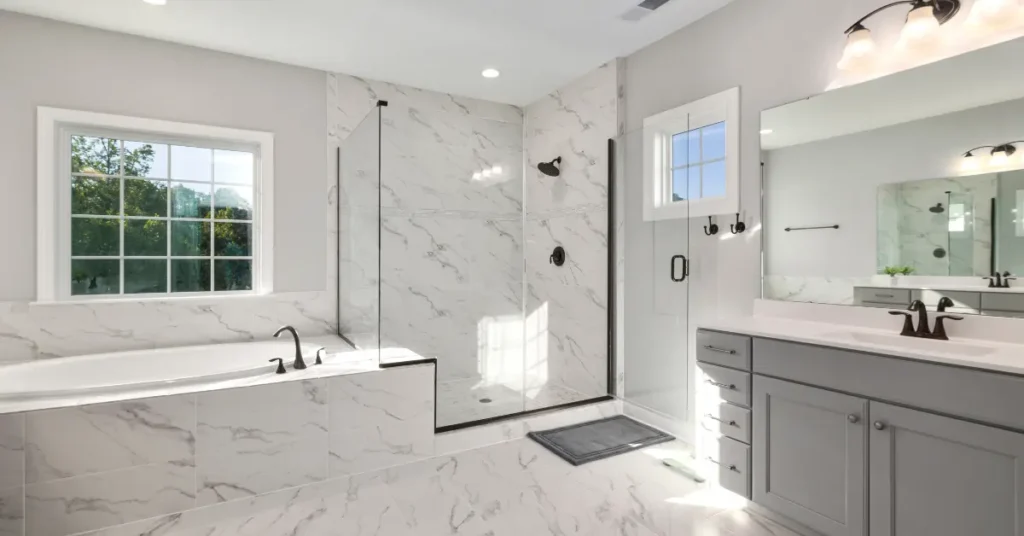Transforming Spaces: Bathroom Design as an Interior Designer

As an interior designer, the bathroom presents a unique challenge and opportunity. It’s a space that combines functionality with aesthetics, where comfort and style must seamlessly intertwine. Whether you’re designing a luxurious master ensuite or a cozy powder room, mastering the art of bathroom design requires careful planning, attention to detail, and a creative vision. In this comprehensive guide, we’ll explore the principles, tips, and techniques that will help you design stunning bathrooms that exceed your clients’ expectations.
Understanding Client Needs:
Before diving into the design process, it’s essential to understand your client’s needs, preferences, and lifestyle. Consider factors such as family size, daily routines, accessibility requirements, and personal tastes. Are they looking for a spa-like retreat, a minimalist oasis, or a functional family bathroom? By understanding your client’s vision and requirements, you can tailor your design to suit their unique needs and create a space that reflects their personality and lifestyle.
Space Planning:
Effective space planning is crucial in bathroom design, especially when dealing with limited square footage. Start by carefully measuring the space and identifying key architectural features, such as windows, doors, and plumbing fixtures. Consider the flow of movement within the room and ensure that there’s adequate space for essential fixtures and storage solutions.
When planning the layout, prioritize functionality and convenience. Position the toilet, sink, and shower or bathtub in a way that maximizes space and allows for easy access and use. Pay attention to clearances and ensure there’s enough room for doors to swing open and users to move around comfortably.
Storage Solutions:
Storage is often a challenge in bathrooms, where space is at a premium. However, clever storage solutions can help maximize space and keep the room organized and clutter-free. Consider incorporating built-in cabinetry, floating shelves, recessed niches, and vanity units with drawers or shelves. Utilize vertical space with tall cabinets or shelving units, and make use of corners with corner cabinets or shelves.
When designing storage solutions, think about the items that need to be stored, such as toiletries, towels, cleaning supplies, and personal care products. Design storage that is easily accessible and functional, with compartments and organizers to keep items neatly arranged and within reach.
Materials and Finishes:
The choice of materials and finishes plays a significant role in defining the style and ambiance of a bathroom. From flooring and wall tiles to countertops and cabinetry, every material should be carefully selected to achieve the desired look and feel.
When selecting materials, consider factors such as durability, water resistance, ease of maintenance, and aesthetic appeal. Opt for high-quality materials that can withstand the humid and wet conditions of the bathroom environment. Popular options include porcelain tiles, ceramic tiles, natural stone, quartz, and solid surface materials.
In addition to materials, pay attention to finishes such as matte, gloss, textured, or patterned. Finishes can add depth, visual interest, and personality to the space, so choose finishes that complement the overall design scheme and create the desired ambiance.
Lighting Design:
Good lighting is essential in any bathroom design, as it affects both functionality and aesthetics. A well-lit bathroom is not only practical for daily tasks such as grooming and hygiene but also creates a welcoming and comfortable atmosphere.
When designing the lighting scheme, consider layering different types of lighting to provide adequate illumination for various activities and to create ambiance. Include ambient lighting, such as recessed ceiling lights or a central ceiling fixture, to provide overall illumination. Task lighting, such as wall sconces or vanity lights, is essential for grooming tasks such as shaving or applying makeup. Accent lighting, such as LED strips or pendant lights, can be used to highlight architectural features or create visual interest.
In addition to artificial lighting, maximize natural light by incorporating windows, skylights, or light tubes. Natural light not only brightens the space but also creates a sense of openness and connection to the outdoors.
Designing for Wellness:
In recent years, there has been a growing emphasis on designing bathrooms that promote wellness and relaxation. Incorporating elements of biophilic design, such as natural materials, plants, and views of nature, can create a soothing and rejuvenating environment. Consider incorporating features such as a freestanding bathtub with a view, a rain shower surrounded by lush greenery, or a wall-mounted fountain for a spa-like experience.
In addition to aesthetics, prioritize comfort and convenience in bathroom design. Include features such as heated floors, towel warmers, and built-in speakers for music or meditation. Pay attention to ergonomics and accessibility, ensuring that fixtures and fittings are easy to reach and use for users of all ages and abilities.
Conclusion:
Designing a bathroom as an interior designer requires a balance of creativity, functionality, and attention to detail. By understanding your client’s needs, space planning effectively, selecting the right materials and finishes, and incorporating thoughtful lighting and wellness features, you can create stunning bathrooms that exceed expectations. Whether you’re designing a sleek and contemporary ensuite or a cozy and rustic powder room, mastering the art of bathroom design will elevate your interior design practice and delight your clients for years to come.












